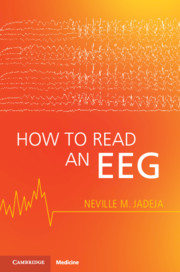Book contents
- How to Read an EEG
- How to Read an EEG
- Copyright page
- Dedication
- Contents
- Figure Contributions
- Foreword
- Preface
- How to Read This Book
- Part I Basics
- Part II Interpretation
- Part III Specific Conditions
- Chapter 18 Common Seizure Mimics
- Chapter 19 Seizures
- Chapter 20 Epilepsies
- Chapter 21 Epilepsy Syndromes
- Chapter 22 Focal Dysfunction (Lesions)
- Chapter 23 Global Dysfunction (Encephalopathy)
- Chapter 24 Status Epilepticus
- Chapter 25 Post Cardiac Arrest
- Chapter 26 Brain Death
- Appendix How to Write a Report
- Index
- References
Chapter 19 - Seizures
from Part III - Specific Conditions
Published online by Cambridge University Press: 24 June 2021
- How to Read an EEG
- How to Read an EEG
- Copyright page
- Dedication
- Contents
- Figure Contributions
- Foreword
- Preface
- How to Read This Book
- Part I Basics
- Part II Interpretation
- Part III Specific Conditions
- Chapter 18 Common Seizure Mimics
- Chapter 19 Seizures
- Chapter 20 Epilepsies
- Chapter 21 Epilepsy Syndromes
- Chapter 22 Focal Dysfunction (Lesions)
- Chapter 23 Global Dysfunction (Encephalopathy)
- Chapter 24 Status Epilepticus
- Chapter 25 Post Cardiac Arrest
- Chapter 26 Brain Death
- Appendix How to Write a Report
- Index
- References
Summary
Seizures (epileptic) are manifestations of transient abnormal excessive or synchronized cerebral neuronal activity. Seizures may be provoked (acute conditions) or unprovoked (epilepsy). Seizures are classified as focal or generalized onset based on consistent clinical observation, EEG and imaging findings. Focal onset seizures originate from a single hemisphere while generalized seizures originate from bilateral hemispheres. Focal seizures may be further classified based on impairment of awareness (anytime during seizure) and motor or non-motor activity (at the very onset). Focal seizures without impaired awareness may not have surface EEG abnormalities. Focal seizures may secondarily generalize, these are now called focal to bilateral tonic clonic seizures. Generalized seizures are associated with impaired awareness, hence only motor or non-motor activity at onset is used to classify them. Common generalized motor seizures include generalized tonic clonic seizures (GTCs), tonic, atonic, myoclonic, myoclonic-atonic and epileptic spasms. Common generalized non-motor seizures include typical and atypical absences, myoclonic absences and absences with eyelid myoclonia.
- Type
- Chapter
- Information
- How to Read an EEG , pp. 177 - 186Publisher: Cambridge University PressPrint publication year: 2021

